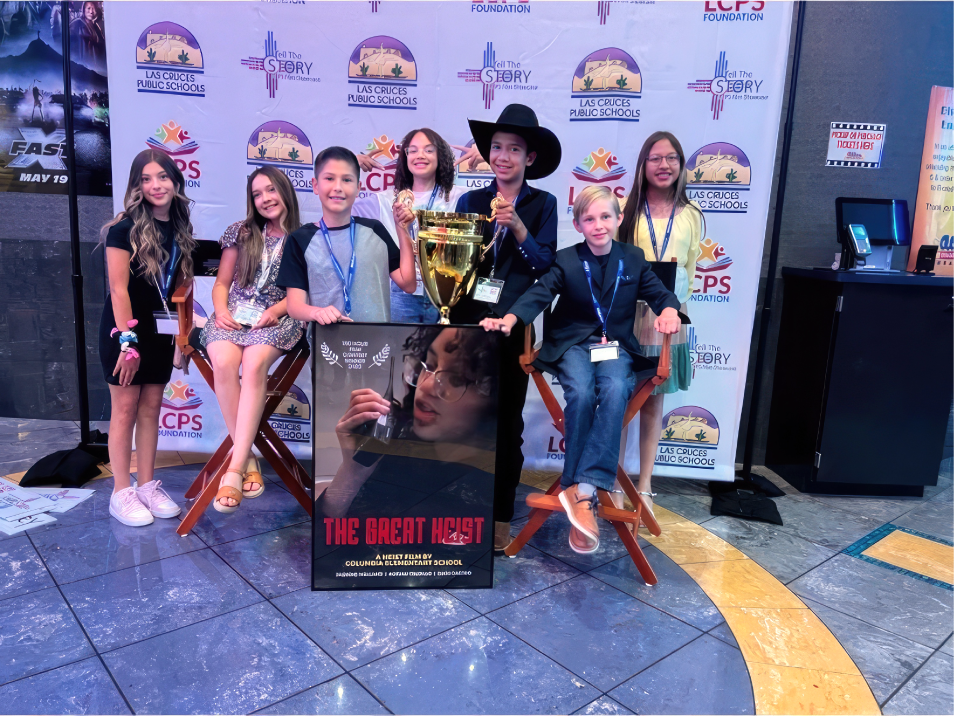School Shoutout: KREN Studio 40 at Las Cruces Public Schools
New Mexico’s Las Cruces Public Schools is giving students hands-on experience in filmmaking and broadcasting.

Look out, Hollywood—there’s heavy competition on the way. Over the last few years, Las Cruces, New Mexico’s rapidly growing film industry has not only helped the local economy, but also earned the desert city national attention. In January 2023, MovieMaker Magazine named Las Cruces as one of the “Best Places to Live and Work as a Moviemaker.” And thanks to the bold dream of a beloved local leader—and a commitment to fulfilling her legacy—Las Cruces Public Schools (LCPS) is making sure every student can share their own story on screen.
Continuing Her Story
It all started with the late Dr. Karen Trujillo. A Las Crucen since her senior year of high school, Trujillo spent 30 years as an educator in New Mexico, serving as state secretary of education before returning to lead LCPS as superintendent in 2019. As she skillfully shepherded students and staff through the pandemic, she began to build her vision for the district. Trujillo wanted to give every student the ability to tell their own story.
This is especially important in a place like LCPS, the second-largest school district in New Mexico. Serving over 25,000 students in the Las Cruces metropolitan area, the district’s 40 school sites are siloed geographically, so finding ways for each campus to tell their own stories—while also contributing to the district’s unified story—was a top priority.
More specifically, Trujillo’s mission was to give all LCPS schools the tools to produce and broadcast their own content—news stories, announcements, student films, and more. In doing so, every student in the district would get hands-on experience in a wide array of filmmaking techniques while also sharing stories from their specific communities. “I think Dr. Trujillo recognized really clearly that the beauty of our school district is that we try to make sure each campus is responsive to and embedded in their local community,” says Chief Technology Officer Josh Silver.
Because LCPS already had successful broadcasting programs at many of its secondary schools, the late superintendent decided that every campus, regardless of grade level, needed its own studio. So Trujillo set out to make her dream a reality. She started by advocating for her students at the state level, securing enough funding from the legislature to build out the district’s existing studios and install 20 new ones on its remaining campuses. Then, while classes met virtually due to the pandemic, studios were built all over the district. Upon the eventual return to school, most LCPS campuses would be ready for students to start producing content. Some schools were even able to use their new equipment virtually.
For their inaugural broadcast, Valley View Elementary School interviewed Trujillo via Zoom. “She had the opportunity to see her work finally play out in the way that she had intended it,” says Kelly Jameson, the district’s director of communications. The young broadcasters at Valley View asked Trujillo what it was like being a superintendent. “The best part about being a superintendent is getting to talk to students like you,” she answered. “It’s my most prized piece of video,” Jameson tells us.
In February of 2021, as the studio rollout was still taking place, Trujillo lost her life in a tragic accident. “It was truly sudden,” Silver tells us. “It just happened one night, just like that, and it was so awful.” It was mere weeks before LCPS was set to return to in-person instruction. Students and staff, who had looked to Trujillo for guidance throughout the pandemic, were in total shock. Outside of her superintendency, Trujillo had also made an unforgettable impact on the region. She’d been elected county commissioner years prior and had been a faculty member at New Mexico State University for over a decade. As a professor and researcher, she devoted most of her time to pre-service teachers and strengthening the state’s student-to-teacher pipeline. “She was very well known in the community, and we deeply felt that loss,” Silver tells us.
After an emotional return to their school buildings, students and staff rallied behind the studio plan like never before. Then the LCPS team realized they could build on Trujillo’s dream to make an even bigger impact. By connecting each school’s studio to the district’s television station, LCPS TV, they could create a network of affiliate stations—40 individual studios at all 40 school sites, all feeding stories to LCPS TV. “We saw the power for our schools to help us highlight their stories on a districtwide level,” Silver explains.
This new network of affiliate stations would need a collective name. The team discussed it and eventually landed on the perfect one. In honor of Dr. Karen Trujillo, they’d call it KREN Studio 40.

A Network of Experiences and Support
Part of Trujillo’s original vision was to ensure that these new studios weren’t seen as something solely extracurricular. They were to be ingrained in the instructional principles of each school site, allowing students to learn through experience. It was important to the LCPS team to maintain that vision.
“Experiential learning is a huge part of our district,” Silver tells us. “It happens everywhere here. So it was foundational that we see the larger concept of media literacy—skills around computational thinking, digital storytelling, and even democracy—as holistic parts of learning. Those skills do not live only in a media class or CTE pathway.”
The result is a uniquely expansive network of state-of-the-art media labs that have all the equipment needed—cameras, computers, sound mixers, you name it—to broadcast content to LCPS TV and video streaming platforms like YouTube. These studios give students in every school hands-on experiences in a variety of areas, from broadcasting, producing, and filmmaking to communications and inclusive practices. And no matter the project, all student work in the studios is aligned to competencies in the district’s Profiles of a Graduate. Similar to Portrait of a Learner, the profiles follow students from kindergarten through 12th grade.
“These profiles outline competencies we as a district and community want each Las Cruces graduate to exhibit before they leave us,” Silver explains. “And they guide a lot of our curriculum, especially something like this, which is usually more project-based.” The graduate profiles are also tiered by age group, with lessons changing to meet competencies at each grade level. “Whether it’s honesty, self-awareness, or showing empathy, they take these skills with them as they grow as students,” Silver adds. “Ultimately, these will help our KREN kids be better communicators and problem solvers.”
Another part of Trujillo’s vision was to have built-in support for the studios at every school. “There is a person who serves as an instructional and technical support to our labs,” says Silver. “Aside from that, we’ve done summer sessions where we train teachers on the LCPS TV side of things.” Although each school runs their lab a little differently, every campus has a teacher onsite who’s in charge of the lab—bringing classes in, supporting students, and sometimes teaching lessons or leading projects, depending on the grade level and school.
To successfully support so many studios—and to better align curriculum to this work—the district provides every lab with the same equipment and software, no matter the grade level. The tools high school students use to make content in a CTE class are the same ones elementary and middle schoolers use to create stories in their own studios. “Our LCPS TV folks really helped us source the right equipment, making sure it all aligned vertically from K through 12, aligning it to our existing LCPS TV equipment, and aligning it to our philosophical and instructional educational goals,” says Silver. “Everyone’s using the same vehicle, but to very different destinations.”
Telling Their Stories
So what are students actually creating in these studios? Well, it runs the gamut. Each campus is given the agency to produce the kind of content they want. In the district’s high schools, media labs are mostly utilized in CTE pathway courses for producing news and student film projects. But at the elementary and middle school levels, students use the studios to produce and broadcast things like morning announcements, sporting events, news stories, video projects for core classes, music videos, animations, and film contest entries. When we spoke to Silver, one of the district’s elementary school affiliates was working on a PSA about recent rattlesnake sightings on campus. “The sky’s the limit,” Silver says.
And it’s not uncommon to find high schoolers in the district watching work produced by elementary students. “We all know how hard it is to connect older kids to younger kids in a community, but we’ve seen lots of our high schoolers going down to the middle schools and elementaries to train kids on the equipment,” says Silver. “That’s a common thing for us now.”
“I can honestly say that when they get to college, our students are going to be set,” says LCPS PR Coordinator Samantha Lewis. “They’ve been working with professional equipment that you see at the college level. They’re using all those tools from an early age, and it’s giving them a big head start when it comes to the world of media or broadcast storytelling.”
As far as successful rollouts go, the district overall has embraced KREN Studio 40. “In some schools, it’s a non-negotiable that every student is a part of this, and everyone in the school community celebrates that,” says Silver. And you can already see the impact on students across LCPS. “We really want the kids to be proud of themselves,” Silver says. “We’re all scared to get in front of the camera, but if everybody has to do it, and there’s a culture around that, then we can overcome our fears together. Be proud to get up there and do your thing. It’s a real confidence boost in a safe space because we’re all getting better as communicators.”
The culmination of KREN Studio 40’s yearlong and bittersweet rollout was the inaugural Tell the Story Film Showcase last May. The film festival featured competition entries from 18 participating schools, all produced using their new or revamped media labs. “We wanted to capture all the work that these studios were creating in a districtwide event,” Silver says. “And whether you were a kindergartener or a senior in high school, all the instructions were the same—they had enough of a framework for success, but we also allowed for independence and creativity. And I’m really proud of that. That’s hard to do.”
At the elementary level, students were challenged to write, produce, and film their entries in just 168 hours while incorporating specific elements, like using a yearbook as a prop. High school students were challenged to do the same, but in just 48 hours. In total, more than 200 students across the district participated in the competition. Entries were then screened at a two-night red carpet event. “We partnered with Allen Theatres, who are tremendous sponsors of ours,” says Silver. “We had four theaters there with two showings each night. And our kids got to walk the red carpet to see their own films.”

As students and parents lined the red carpet, they were interviewed by PR Coordinator Lewis—a former news reporter—and a student reporter named Zaydrien, whose man-on-the-street style interviews nearly stole the show. Inside, student short films—ranging from ominous dramas to slapstick heist comedies to stop-motion animations—flashed across the screen to a captivated audience of Las Crucens, all connected by the power of story. “To have hundreds of students contributing to the goal of storytelling was such a collective standing ovation for us to finally see,” says Jameson.
As KREN Studio 40 evolves, Silver believes these labs can be used for new endeavors that will help the district tell its collective story, like recruitment videos and testimonials. But the impact this project has already had on the district’s students is awe-inspiring to say the least. “This is a way for every kid to feel empowered and unique in their creativity,” Silver explains. “And they’re not just learning new skills; they’re making something. They own these films. Those are theirs.”
There’s no doubt that Dr. Trujillo left quite a mark on Las Cruces, and her legacy will only continue to shape this city of storytellers. “This was her home,” Silver says. “She would often say we have the people and skills and tools we need right here. We just need to leverage them. She believed that fully, and she really wanted to make this the best place possible.”
In October 2020, Trujillo wrote a guest column for the Las Cruces Sun-News about finding hope during the pandemic. How better to end this story about hope—a story that started with Trujillo herself—than to give her the final word? “It would be easy to get stuck in the darkness,” she wrote, “but we can’t. We each have to find a way to see some light. I see it in our students.”

Corey Whaley is a writer with SchoolCEO and can be reached at corey@schoolceo.com.
Subscribe below to stay connected with SchoolCEO!

